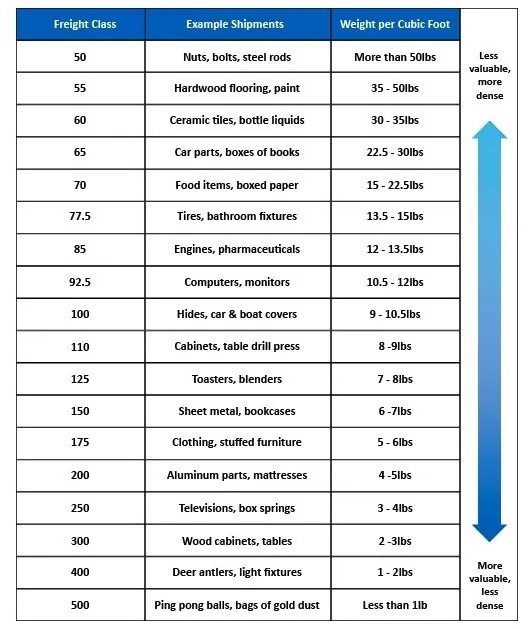
Freight Density Calculator
Calculate your freight density easily with our Freight Density Calculator. Optimize shipping costs by determining accurate freight classes based on weight and volume. Try it now!
Explore More Freight Shipping Tools and Resources
Getting Freight Class Right Freight Class Calculator Freight Quote ToolSimplify Freight Shipping with Our Freight Density Calculator
Thousands of businesses trust FreightCenter to move their freight faster, smarter, and cheaper! From unbeatable rates to top-notch service, our customers are raving about their shipping success.
See why they keep coming back!
Award-Winning Service, Trusted by Shippers Everywhere!
- 2021, 2017 & 2016 Food Logistics’ Top Green Providers
- 2021 & 2018 Supply & Demand Chain Executives’ Pros to Know: Matthew Brosious
- 2020 & 2019 Top Food Logistics’ 3PL & Cold Storage Provider Award
- 2020 & 2019 Business Observer’s Top 500 Companies on the Gulf Coast
- 2020 & 2017 SmartWay® Transport Partner
- 2020 & 2017 Food Logistics’ Champions: Rock Stars of the Supply Chain
- 2020 Best of Palm Harbor Awards for Local Businesses
- 2017 Green Supply Chain Award from Supply & Demand Chain Executive
- 2017 Tampa Bay Business Journal Heroes at Work
- 2016, 2015, & 2012 Food Logistics Top 100 Software and Technology Providers
- 2013 Tampa Bay Business 100 by Tampa Bay Business Journal
- 2013 Top 100 Great Supply Chain Partners by SupplyChainBrain
- 2012 TIA Samaritan Award Honorable Mention
- 2012, 2011 & 2010 TBBJ Fast 50 Recipient
- 2013, 2011, & 2010 Diversity Business Top Businesses

What Is Freight Density?
What Is A Freight Density Calculator?
A Freight Density Calculator is an online tool that helps shippers and carriers calculate a shipment’s density to determine its freight class. The tool asks for the measurement’s dimensions, weight, origin, and destination zip codes and uses this information to calculate the measurement’s pounds per cubic foot (PCF).
How to Use the Freight Density Calculator
How Is LTL Class Density Calculated?
LTL (Less Than Truckload) class density is calculated using a freight density calculator, which applies a simple formula:
Freight Density (lbs/ft³) = Weight of Shipment (lbs) ÷ Total Cubic Feet of Shipment
To find the total cubic feet:
- Measure the length, width, and height of your shipment in inches.
- Multiply these dimensions to calculate the total cubic inches.
- Divide the cubic inches by 1,728 (the number of cubic inches in a cubic foot) to get the total cubic feet.
For example:
- Shipment dimensions: 48″ x 40″ x 24″
- Total weight: 800 lbs
- Cubic feet: (48 × 40 × 24) ÷ 1,728 = 26.67 ft³
- Density: 800 lbs ÷ 26.67 ft³ = 30 PCF (pounds per cubic foot)
Why Freight Density Matters
The calculated freight density helps determine the shipment’s class, influencing shipping costs. Higher density often means a lower freight class and reduced costs, while lower density results in higher freight classes and increased costs.
LTL carriers also use the NMFC number (a standardized code) to determine density to assign a freight class ranging from 50 to 500. Items like bricks with higher density typically have a lower class and cost less to ship than lightweight items like pillows.
Using a freight density calculator, you can avoid reclassification fees, ensure accurate freight quotes, and streamline your shipping process.
Freight density plays a huge role in determining shipping costs and freight classes across various shipping modes. Whether you're shipping by truck, air, or ocean, calculating density ensures accurate pricing and efficient space utilization. Here are some common shipping methods where freight density calculations come into play.
Freight density directly impacts pricing in LTL shipping, as carriers charge based on the freight class, which is determined by density. Higher density goods typically incur lower rates.
Higher density freight allows for full utilization of a truck's weight capacity, optimizing shipping costs. Low-density freight may lead to "cubing out" before reaching the truck's weight limit, resulting in higher costs per unit.
In intermodal transport (using multiple modes of transport, such as rail and truck), freight density affects container loading efficiency. High-density goods maximize container space, lowering per-unit costs.
Similar to other modes, the density of goods affects how much can be packed into a container. Higher density freight maximizes the space within a container, reducing overall shipping costs.
Services like refrigerated trucking are affected by freight density, as denser loads may require more energy to maintain temperature, affecting operational costs.
For small packages, density affects dimensional weight pricing, which determines the cost based on the space a package occupies rather than its actual weight.
Dense freight might increase the weight-to-volume ratio, potentially maximizing the efficiency of railcars, which are built to carry heavy loads over long distances.
Air freight is highly sensitive to freight density because airlines calculate charges based on either the actual weight or the volumetric weight, whichever is higher.


Key Factors in Freight Density Calculations
A freight density calculator is used to determine a shipment’s density, which directly impacts its freight class and shipping costs. The factors considered in a freight density calculator include:
- Weight of the Shipment
- The total weight of the shipment is in pounds (lbs). This is critical for calculating the pounds per cubic foot (PCF).
- Dimensions of the Shipment
- The shipment’s length, width, and height are measured in inches. These dimensions determine the total volume of the shipment.
- The volume of the Shipment
- The total volume is calculated by multiplying the dimensions (length × width × height). The result is in cubic inches, which are converted to cubic feet by dividing by 1,728 (the number of cubic inches in a cubic foot).
- Freight Density Formula
- The formula used is:
Freight Density (lbs/ft³) = Weight of Shipment (lbs) ÷ Volume in Cubic Feet
- The formula used is:
- Packaging
- Proper packaging that reflects the true actualnsions of the shipment, including pallets or crates, is crucial for accurate calculations.
- Stackability (Optional)
- While not always a direct input in the calculator, the ability to stack shipments can influence how carriers view density and assign freight classes.
Combining these factors, the freight density calculator provides the shipment’s density, measured in pounds per cubic foot, which is crucial for determining the appropriate freight class and shipping cost.
Freight Density FAQs
These FAQs should help clarify questions about freight density and its importance in shipping. Contact our support team or explore our other shipping resources for further assistance.
Q. What is freight density?
Freight density is the weight of a shipment in relation to its volume, expressed in pounds per cubic foot (PCF). It is calculated by dividing the shipment’s weight (in pounds) by its total cubic feet.
Q. How do I calculate freight density?
To calculate freight density:
- Measure the shipment’s length, width, and height in inches.
- Multiply these dimensions to find the total cubic inches.
- Divide the cubic inches by 1,728 to convert to cubic feet.
- Divide the shipment’s weight (in pounds) by the cubic feet to get the density.
Q. Why is freight density important?
Freight density is critical for determining the shipment’s freight class, which impacts shipping costs. Higher density typically results in lower freight classes and reduced costs, while lower density leads to higher freight classes and higher costs.
Q. What is the role of the NMFC number in freight density?
The NMFC (National Motor Freight Classification) number is a standardized code used alongside freight density to assign a freight class. It considers the shipment’s characteristics like density, handling, and liability.
Q. How does the Freight Density Calculator work?
The Freight Density Calculator uses your shipment’s weight and dimensions to compute the density in pounds per cubic foot. Input the details, and the tool provides accurate results instantly.
Q. Can I use the Freight Density Calculator for LTL shipments?
Yes, the Freight Density Calculator is ideal for Less Than Truckload (LTL) shipments. It helps determine the density and ensures accurate freight class and shipping quotes.
Q. What happens if my freight density is calculated incorrectly?
Incorrect freight density can lead to misclassification, resulting in reclassification fees and inaccurate shipping costs. Using a reliable Freight Density Calculator helps avoid these issues.
Q. Do carriers use freight density for all shipments?
Most carriers use freight density to determine freight class, especially for LTL shipments. Some carriers also rely on density-based freight classification for items not covered by specific NMFC codes.
Q. What Types of Freight Require Density Calculations?
Density calculations are required for most types of freight, especially for Less Than Truckload (LTL) shipments. Full Truckload (FTL) shipments may also require density calculations depending on the nature of the cargo and the carrier’s requirements.
Q. Is Freight Density the Only Factor in Determining Freight Class?
No, while density is a significant factor, other elements such as stowability (how easily the freight can be stored), handling requirements, and liability (the value and risk of damage) also contribute to determining the final freight class.
Top 3 Advantages of Using a Freight Density Calculator
Accurate Freight Class Determination
A freight density calculator ensures you determine the correct freight class for your shipment, reducing the risk of reclassification fees and unexpected charges. This helps you maintain transparency and control over shipping costs.
Optimized Shipping Costs
By calculating the precise freight density, you can identify opportunities to optimize your shipping. Higher density often leads to lower shipping rates, helping you save money on your logistics operations.
Improved Logistics Efficiency
With instant, reliable calculations, a freight density calculator simplifies the shipping process, enabling better freight management and decision-making. It ensures accuracy and consistency, which is essential for both small-scale and large-scale shipping operations.

